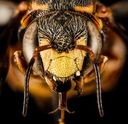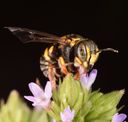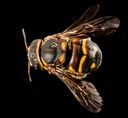Wool-carder, Resin, Pebble, and Allied Bees
Anthidiini
Classification
- Phylum: Arthropoda
- Subphylum: Hexapoda
- Class: Insecta
- Order: Hymenoptera
- Family: Megachilidae
- Subfamily: Megachilinae
- Tribe: Anthidiini
Pronunciation
How to pronounce Anthidiini: //ænˈθɪ.di.aɪˌnaɪ//
These audio files are automatically generated. While they are not always 100% accurate, they are a good starting point.
Images






Summary
Anthidiini is a tribe of bees in the family Megachilidae, including about 140 species in 6 genera locally, and over 830 species in around 40 genera worldwide. They are known for their diversity and are represented by various genera such as Anthidium (wool-carder bees) and Anthidiellum (rotund resin bees).
Distribution
Worldwide, with at least 840 described species in approximately 40 genera.
Evolution
Strong evidence suggests that the tribe Anthidiini is monophyletic.
Similar Taxa
Tags
- Anthidiini
- Wool-carder Bees
- Resin Bees
- Pebble Bees
- Insects